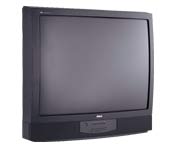 |


TechnoFILE is copyright and a registered trademark © ® of
Pandemonium Productions.
All rights reserved.
E-mail us Here!

Building a Theater at HomeBy Jim Bray Part One (this article): First Steps Part Two: The Components We Used Part Four: Buying a Projection TV Part Eight: More on Buying Speakers If you’ve had enough of paying through the nose for movie tickets, only to have your feet stick to the floor and be assaulted and insulted by commercials, it’s time to stop throwing money into the street and start investing in your own home theater. Building a home theater can be fun and rewarding. It can also be intimidating, however, so you should start by asking a few questions like: How much shall I spend? How do I set up the room? What sort of store should I trust? These are all legitimate questions, but they shouldn’t cause you excessive angst. These are, after all, merely toys for grownups. Still, you should do some homework. So, in this and a few upcoming columns, I’ll outline some considerations I think are important to your long term enjoyment of your home cinema. Hopefully, they’ll help point you in the right direction and give you the confidence you need to sally forth bravely into the retailers’ dens. First of all, what is a home theater? A home theater is merely a collection of audio and video components hooked together. It can be as simple as a TV and VCR hooked into a basic stereo system, or as complex as a house-shattering extravaganza that dazzles your eyes and makes your ears bleed. Some or all of your equipment can be new, depending on your budget and how happy you are with your existing toys. I’m very happy with my twelve year old speakers, for example, so that lets me budget elsewhere. Start by choosing where your home theater will be located. Chances are it’ll be in your living room or family room, unless you have a spare area you can shape from scratch. Take your preferred configuration into consideration as well: if your room is rectangular, as most are, are you going to use a long or a short wall for your display? It makes a difference. Using the long wall, for instance, makes for a wide but shallow theater, while using the short wall will let you sit farther back from the screen. Also, the long wall lets you spread your speakers farther apart, whereas the short wall lets you put your surround speakers farther back. You must decide which configuration will work best for you. In our home, we chose the family room, placing the electronics along the long wall. I would have preferred using the short wall, but some fool put a fireplace there – and to narrow the choices down further, our living room was totally impractical. Next, set your budget – with the rule of thumb being that you’ll inevitably find that the components with which you fall in love will cause that budget to swell. So use your budget as a rule of thumb, not an absolute – unless you have more will power than I do. Once your room and your budget are decided, it’s time to start looking for the pieces to make up the whole. To use as examples for these columns, Thomson Consumer Electronics supplied an RCA 36 inch digital TV/computer monitor, a five disc DVD Changer, VHS Hi-Fi VCR, wireless speakers, and miscellaneous accessories. For the audio, Rotel Corporation kicked in a wonderful THX Ultra preamplifier/surround processor and a separate power amplifier that are truly awesome. This home theater, sans speakers, tipped the scale at about $7000. To augment my lovely old speakers, we went a bit wild and added an M&K THX-certified subwoofer, which brought the total budget for new toys to about eight grand. You don’t need to spend nearly that much to get very satisfying results. For instance, you can buy a “Dolby Digital ready” audio/video receiver (it lacks the built in Dolby Digital decoder but accepts all the inputs) for less than $250, and big screen TV’s start at under two grand. This won’t give you the performance or longevity as something more high end, but so what? Many people don’t need to go all out. You can also defer part of your investment for later, either for financial reasons or to advance your state-of-the-art as the art improves. If your TV still works fine, for instance, keep it – then go HDTV when the sets are more affordable and more software is available. Next time, I’ll explain why I chose these particular components. Jim Bray's technology columns are distributed by the TechnoFILE and Mochila Syndicates. Copyright Jim Bray.
|
|
|
| Support TechnoFile via Paypal |
| TechnoFILE's
E-letter We're pleased to offer our FREE private, subscription-based private E-mail service. It's the "no brainer" way to keep informed. Our Privacy Policy |